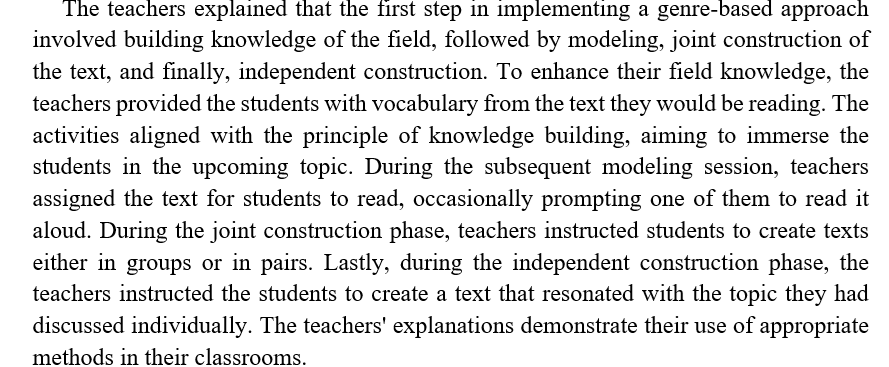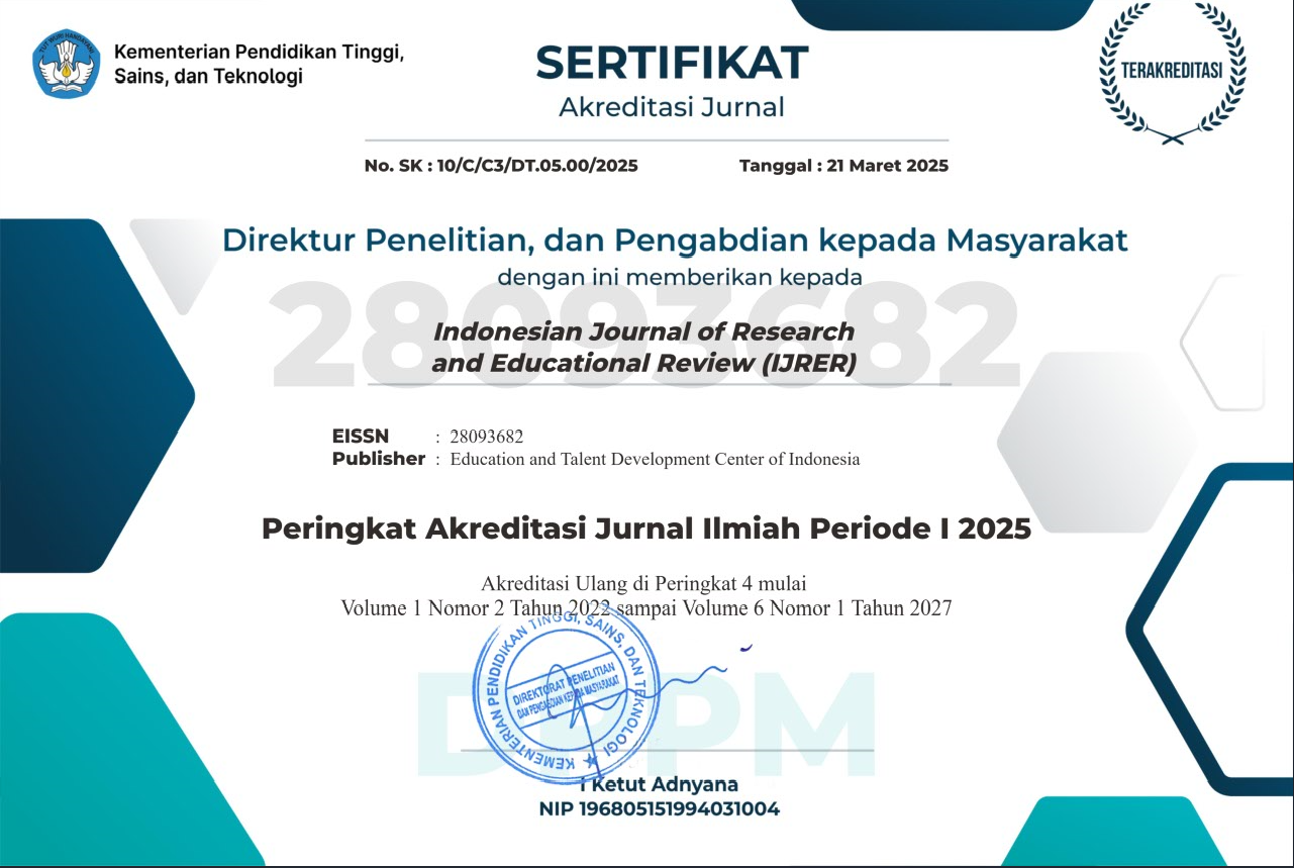The Implementation of A Genre-Based Approach in Public Senior High Schools: A Study for Teacher Understanding
https://doi.org/10.51574/ijrer.v4i1.356
Keywords:
Genre Based Approach, Lesson Plan, Syllabus, Teachers’ Understanding, Teachers’ AttitudeAbstract
The research aims to know what the implementation of the genre-based approach in public senior high school 2 Gowa is. The focus of this research is on the teachers' comprehension of the Genre-Based Approach (GBA), their attitudes towards its implementation, and the creation of syllabi and lesson plans. The method used is qualitative research. We conducted the research at public senior high school 2 Gowa. The researcher collected the data through a combination of interviews, observations, and documentation. The researcher employs data analysis techniques that include data reduction, data presentation, and conclusion drawing. While teachers understand the application of the genre-based approach, they struggle to implement its steps. Teachers exhibit a positive attitude toward the implementation of GBA. The development of syllabi and lesson plans adheres to the planning and implementation steps, but it does not follow the evaluation and revision step. The teachers in this school encounter challenges stemming from the students' competence and motivation.
References
Aswani, A., Simatupang, N. N., Yusuf, M., & Adha, T. K. R. (2023). Genre-based approach implementation in teaching listening: A case study in senior high school in Indonesia. Theory and Practice in Language Studies, 13(5), 1197-1203.
Blaikie, F., & Maras, K. (2024). Epistemologies and Aesthetics of Curriculum, Pedagogical Praxis and Assessment in the Visual Arts: A Comparative Analysis of the International Baccalaureate Diploma Programme and the New South Wales Stage 6 Visual Arts Syllabus. International Journal of Art & Design Education, 43(1), 99-113.
Cheng, L., & Fox, J. (2017). Assessment in the language classroom: Teachers supporting student learning. Bloomsbury Publishing.
Ilham, I., & Aminullah, A. (2018). The implementation of genre-based approach in teaching discussion text. Paedagoria: Jurnal Kajian, Penelitian dan Pengembangan Kependidikan, 5(1), 52-65.
Hermansson, C., Jonsson, B., Levlin, M., Lindhé, A., Lundgren, B., & Norlund Shaswar, A. (2019). The (non) effect of joint construction in a genre-based approach to teaching writing. The Journal of Educational Research, 112(4), 483-494.
Iqbal, M. H., Siddiqie, S. A., & Mazid, M. A. (2021). Rethinking theories of lesson plan for effective teaching and learning. Social Sciences & Humanities Open, 4(1), 100172.
Jiang, L., Yu, S., & Lee, I. (2022). Developing a genre-based model for assessing digital multimodal composing in second language writing: Integrating theory with practice. Journal of Second Language Writing, 57, 100869.
Kessler, M., & Polio, C. (Eds.). (2023). Conducting genre-based research in applied linguistics: A methodological guide. Taylor & Francis.
Khasanah, N., Faridi, A., & Wahyuni, S. (2023). The Implementation of Genre-Based Approach Through Project-Based Learning in Teaching Writing. English Education Journal, 13(3), 465-475.
Kim, J. (2024). Leading teachers' perspective on teacher-AI collaboration in education. Education and Information Technologies, 29(7), 8693-8724.
Kim, Y. S. G., Wolters, A., & Lee, J. W. (2024). Reading and writing relations are not uniform: They differ by the linguistic grain size, developmental phase, and measurement. Review of Educational Research, 94(3), 311-342.
La Oni, G. M. (2022). Exploring Students' Writing at the English Language Education Study Program. Edusia: Jurnal Ilmiah Pendidikan Asia, 2(1), 1-19.
Liu, C., & Chen, M. (2022). A genre-based approach in the secondary school English writing class: Voices from student-teachers in the teaching practicum. Frontiers in Psychology, 13, 992360.
Lo, Y. Y., & Jeong, H. (2018). Impact of genre-based pedagogy on students’ academic literacy development in Content and Language Integrated Learning (CLIL). Linguistics and Education, 47, 36-46.
Nagao, A. (2018). A genre-based approach to writing instruction in EFL classroom contexts. English Language Teaching, 11(5), 130-147.
Peralta-Castro, F. (2021). Improving the relevance of an English syllabus within a top-down teaching context. RIDE. Revista Iberoamericana para la Investigación y el Desarrollo Educativo, 12(23).
Prihananto, N. (2021). Communicative approach in the five curricula of English subject for secondary schools: A paradox in English language teaching in Indonesia. ScienceOpen Preprints.
Romiszowski, A. J. (2024). Producing instructional systems: Lesson planning for individualized and group learning activities. Taylor & Francis.
Rose, D. (2013). brief introduction to the principles of analysis, exemplified with a few of the genres described to date, including types of stories, reports, explanations, arguments and text reponses. To begin with, the model of social context underpinning the approach is briefly outlined. The Routledge Handbook of Discourse Analysis, 209.
Santos, M., Palacios, M. C., Cheuk, T., Greene, R., Mercado-Garcia, D., Zerkel, L., ... & Skarin, R. (2018). Preparing English learners for college and career: Lessons from successful high schools. Teachers College Press.
Sukyadi, D. (2015). The teaching of English at secondary schools in Indonesia. In Secondary school English education in Asia (pp. 123-147). Routledge.
Yan, J., Jones, B., Smith, J. J., Morgan, P., & Eather, N. (2022). A systematic review investigating the effects of implementing game-based approaches in school-based physical education among primary school children. Journal of Teaching in Physical Education, 42(3), 573-586.

Downloads
Published
How to Cite
Issue
Section
License
Copyright (c) 2025 ETDC: Indonesian Journal of Research and Educational Review

This work is licensed under a Creative Commons Attribution-ShareAlike 4.0 International License.

























